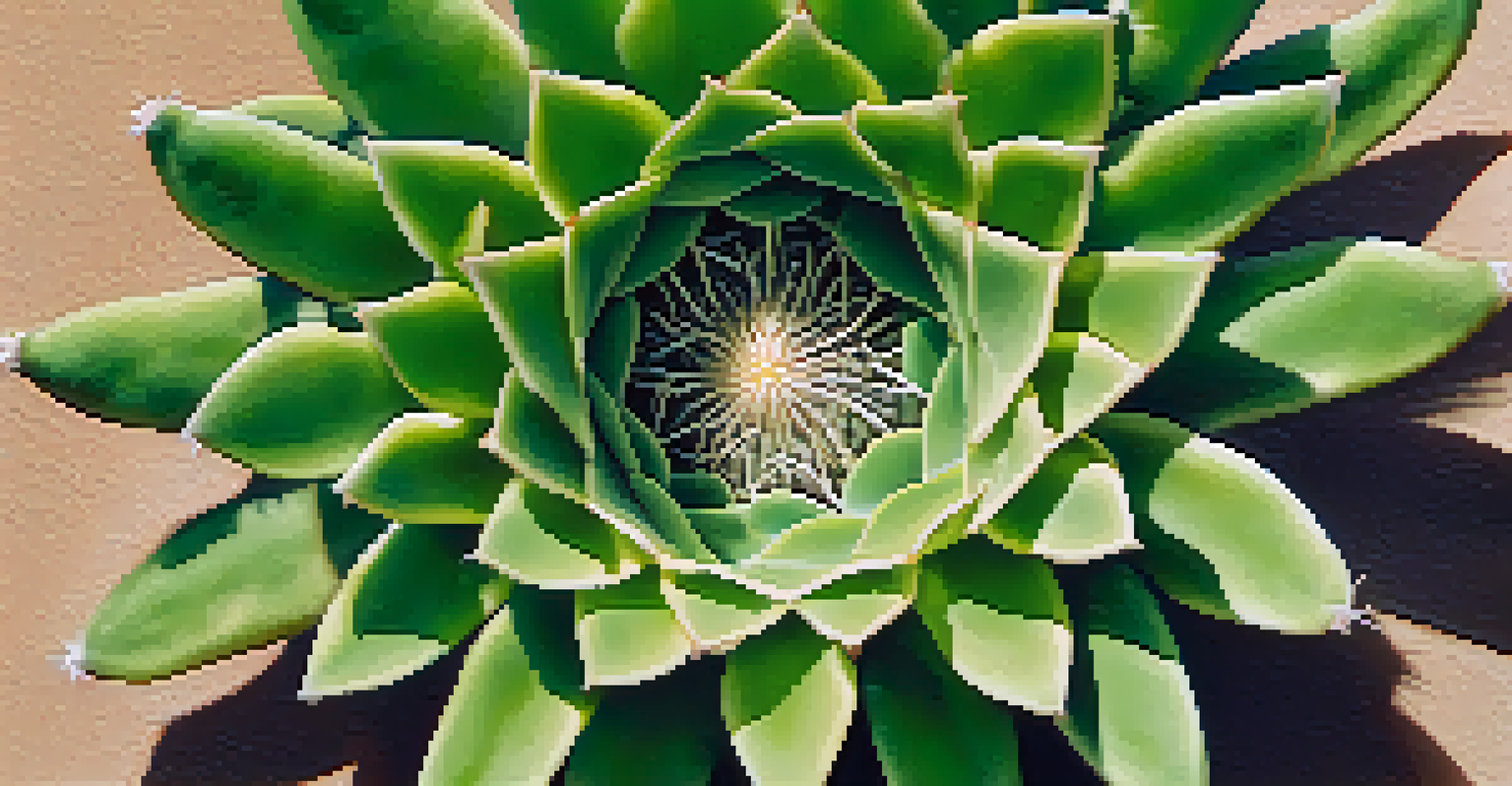Psychoactive Experiences: Subjective Reports on Peyote Use

Understanding Peyote: A Cultural and Historical Overview
Peyote, a small cactus native to Mexico and the southwestern United States, has been used for thousands of years in various spiritual and cultural practices. Its psychoactive properties are primarily due to a compound called mescaline, which induces altered states of consciousness. For many Indigenous communities, peyote is not merely a substance but a sacred plant integral to their rituals and healing practices.
Psychedelics can help to catalyze the process of self-discovery and healing, providing insights that can lead to profound personal transformations.
Historically, peyote has been a part of Native American religious ceremonies, particularly within the Native American Church. This organization uses peyote as a sacrament, emphasizing its role in connecting individuals with the divine. Understanding this cultural context is essential when discussing subjective experiences, as they are often deeply intertwined with personal and communal beliefs.
As people from diverse backgrounds begin to explore peyote, it's crucial to recognize that their experiences may differ significantly from those of Indigenous users. Factors such as intention, setting, and cultural background can greatly influence the nature of the psychoactive experience, making each report unique.
Psychoactive Effects: What Users Commonly Report
Users of peyote often describe a range of psychoactive effects that can vary widely in intensity and duration. Commonly reported experiences include vivid visual hallucinations, altered perceptions of time, and profound emotional insights. Many individuals find that these effects can lead to moments of deep introspection and self-discovery, offering them new perspectives on their lives.

In addition to visual and emotional changes, users frequently report a sense of connection to nature and the universe. This feeling can manifest as a heightened appreciation for the environment or a sense of unity with all living things. Such experiences often resonate with the spiritual beliefs that underpin peyote use, reinforcing the notion that these sessions can be transformative.
Peyote's Cultural Significance
Peyote is a sacred plant for Indigenous communities, integral to their spiritual and healing practices.
However, it's essential to note that not all experiences are positive. Some users report anxiety, confusion, or overwhelming emotions, especially if they are unprepared for the intensity of the experience. This variability highlights the importance of a supportive environment and a clear understanding of personal intentions before engaging with peyote.
Setting and Intention: Key Factors in Peyote Experiences
The setting in which peyote is consumed plays a crucial role in shaping the overall experience. Many users emphasize the importance of a safe, comfortable environment, often surrounded by trusted individuals. A supportive setting can foster a sense of security, allowing users to explore their inner landscapes without fear or distraction.
The use of sacred plants like peyote is not merely about the experience; it's about connecting with the history and the culture that surrounds it.
Intention is another critical factor that influences the nature of peyote experiences. Users who approach the experience with specific goals—whether for healing, spiritual growth, or self-reflection—often find that their journeys align closely with these intentions. This focused mindset can help guide the experience, making it more meaningful and impactful.
Conversely, those who partake without a clear intention or in a chaotic setting may encounter more challenging experiences. This unpredictability underscores the need for preparation and mindfulness, ensuring that users are equipped to navigate the psychological terrain they may encounter during their peyote journey.
Personal Narratives: Insights from Peyote Users
Listening to personal narratives provides a rich tapestry of insights into the subjective experiences of peyote users. Many individuals share stories of profound realizations and emotional breakthroughs, often describing moments of clarity that have shaped their lives. These anecdotes illustrate the diverse ways peyote can impact personal growth and understanding.
For example, one user recounted an experience where they confronted deep-seated fears and insecurities, ultimately emerging with a newfound sense of self-acceptance. This transformative moment highlights how peyote can facilitate introspection and healing, allowing individuals to work through past traumas in a safe space.
Impact of Setting and Intention
The experiences users have with peyote can greatly vary based on their setting and personal intentions.
However, not all stories are solely positive; some users share challenging tales of anxiety or confusion during their experiences. These narratives serve as reminders that while peyote can be a powerful tool for exploration, it also demands respect and careful consideration.
Comparative Psychoactive Experiences: Peyote vs. Other Substances
When comparing peyote to other psychoactive substances, such as psilocybin mushrooms or LSD, notable differences and similarities emerge. Like peyote, these substances can induce altered states of consciousness and profound emotional experiences. However, the specific effects and sensations can vary widely, influenced by the unique chemical compositions of each substance.
For instance, while peyote often elicits a sense of connection with nature, users of psilocybin may experience more vivid visual distortions and a sense of oneness with the universe. This distinction can significantly affect the nature of the insights gained during the experience, leading to different interpretations and outcomes.
Understanding these differences can aid individuals in selecting the right substance for their desired experience. It also emphasizes the importance of context, as the cultural and historical backgrounds of these substances can shape user experiences in unique ways.
The Therapeutic Potential of Peyote: Emerging Research
Recent studies have begun to explore the therapeutic potential of peyote and its active compound, mescaline, especially in treating conditions like depression and PTSD. Preliminary findings suggest that peyote can facilitate meaningful psychological breakthroughs, helping individuals confront and process traumatic memories. This emerging research points to the importance of integrating traditional practices with modern therapeutic approaches.
As mental health professionals increasingly recognize the benefits of psychedelic substances, peyote’s role in therapy is gaining attention. Users often report that their experiences lead to improved mental well-being and a deeper understanding of their emotional struggles. This potential for healing has sparked interest in how peyote could be utilized in structured therapeutic settings.
Emerging Therapeutic Research
Recent studies suggest that peyote may have therapeutic potential, particularly for treating conditions like depression and PTSD.
However, further research is necessary to fully understand the safety, efficacy, and long-term impacts of peyote use in therapeutic contexts. As the field evolves, it’s vital to approach these studies with respect for the cultural significance of peyote and the individuals who have used it for generations.
Legal and Ethical Considerations Surrounding Peyote Use
The legal status of peyote varies significantly across different regions, often complicating its use in both spiritual and therapeutic settings. In the United States, for example, peyote is legal for use by members of the Native American Church but remains classified as a Schedule I substance for others, making access a contentious issue. This legal landscape raises important ethical questions about who has the right to use peyote and under what circumstances.
Ethical considerations also extend to the potential exploitation of Indigenous practices surrounding peyote. As interest in psychedelics grows, there is a risk of cultural appropriation, where non-Indigenous individuals adopt peyote use without understanding or respecting its cultural significance. This highlights the need for sensitivity and awareness when discussing and engaging with peyote.

Navigating these legal and ethical complexities requires a thoughtful approach, emphasizing the importance of cultural respect and open dialogue. As society continues to explore the psychoactive potential of peyote, it is crucial to honor its roots and the people who have historically used it.